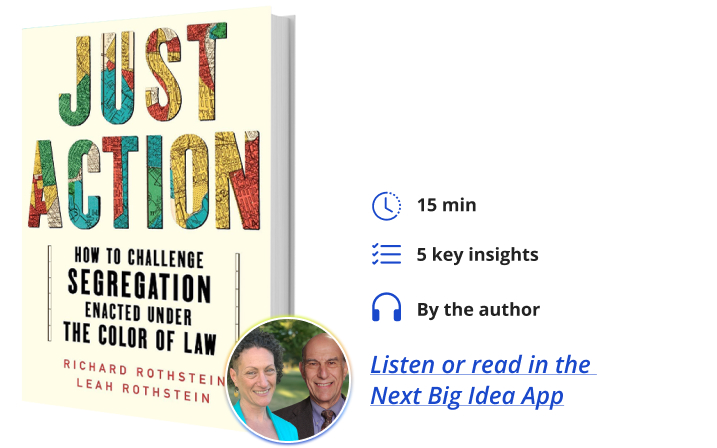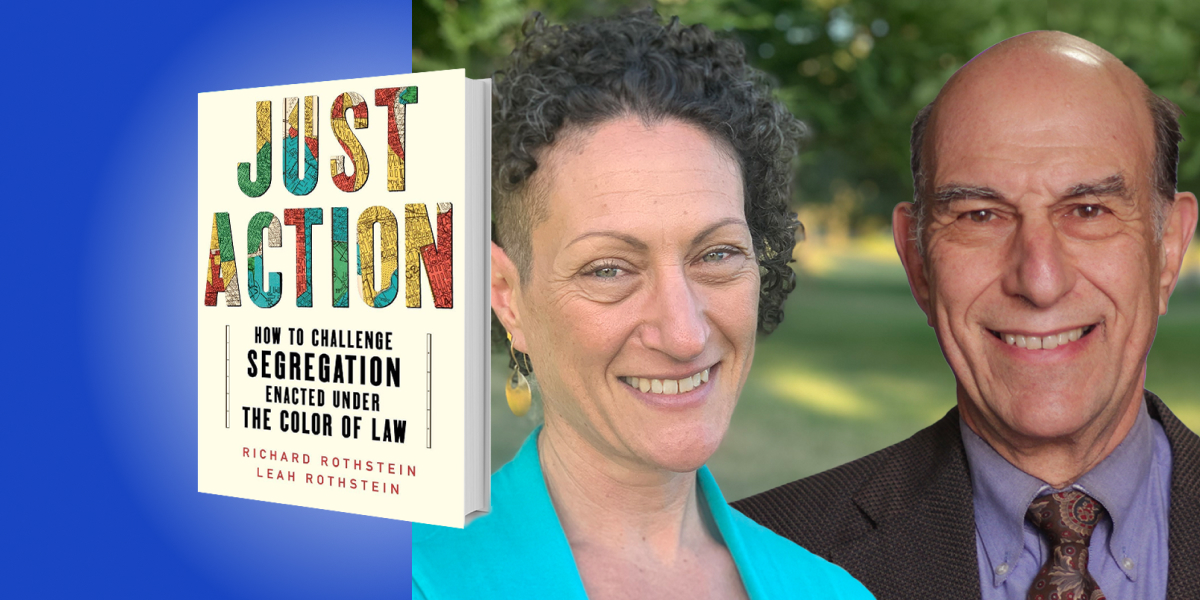Leah Rothstein is a former community and union organizer, housing and community development policy consultant, and criminal justice reform researcher.
Richard Rothstein is a Distinguished Fellow of the Economic Policy Institute and a Senior Fellow (emeritus) at the Thurgood Marshall Institute of the NAACP Legal Defense Fund.
Below, Leah and Richard share 5 key insights from their new book, Just Action: How to Challenge Segregation Enacted Under the Color of Law. Listen to the audio version—read by Leah—in the Next Big Idea App.

1. Racial segregation in our communities underlies our most serious social problems.
The civil rights movement of the mid-twentieth century made great strides in desegregating lunch counters and transportation in the South. Then followed law schools, universities, the military, and with Brown vs. Board of Education, the legal segregation of elementary and secondary schools throughout the country. The Fair Housing Act of 1968 then outlawed discrimination in the sale and rental of housing.
However, despite these victories, the racial segregation of our neighborhoods still remains. Today, every metropolitan area in every region of the country is segregated by race, with some neighborhoods that are all or mostly African American and some that are all or mostly white.
This is no benign separation. It is not only the segregation of people but also the segregation of resources. African American neighborhoods are consistently more impoverished and under-resourced than white neighborhoods. African American children live in areas with more pollution and exposure to lead paint than white children; they have higher rates of asthma and lead poisoning. They grow up to have higher rates of cardiovascular disease and cancer and lower life expectancies than whites. They have more exposure to crime and violence and discriminatory police contact, all leading to higher stress levels. Their neighborhoods have fewer grocery stores selling healthy food, but more fast food options. Fewer bank branches but more nontraditional financial institutions like payday lenders that charge exorbitant interest rates. African American children in segregated neighborhoods then go to schools where every student faces one or more of these challenges. Their schools are overwhelmed and as a result, everyone’s education suffers. White children growing up in segregated white neighborhoods are less likely to face these obstacles.
2. We need a new activated civil rights movement.
There is an appetite for change in the U.S. around racial inequality. In 2020, following George Floyd’s murder, 20 million Americans, black and white, urban and suburban, young and old, marched in Black Lives Matter demonstrations around the country. Many then came home and put lawn signs in front of their homes and a few even started book clubs to study and discuss racial disparities. That massive involvement, more marching for racial justice in 2020 than at any time in our history, did not translate into improvements in the racial segregation of our communities.
“We can start by creating bi-racial, multiethnic committees in our own communities.”
For progress to be made, we need an energized civil rights movement that takes on residential segregation. To do this, we can start by creating bi-racial, multiethnic committees in our own communities. These groups can begin by learning how their neighborhoods came to be segregated and then can pursue any of dozens of policies and strategies that can be implemented locally to make a real difference in redressing segregation.
A group of housing activists in Modesto, California began working together after residents discovered that when their own homes were built, African Americans were explicitly prohibited from buying them. These residents then involved high school students to research how prevalent these racial restrictions were in their town and created an educational campaign to raise awareness and inspire action amongst their neighbors. They are now working with local civil rights organizations to get their city to build affordable housing on the site of a vacant golf club that the city owns. Groups around the country can get started just like these residents did in Modesto.
3. There is a lot we can do to challenge and remedy segregation.
These are areas where the concentration of poverty is the direct result of government-sponsored segregation. We should be concerned with increasing resources in these places as well as adopting anti-displacement policies. For example, policies like protections for renters against rising rents and unjust evictions mean long-time residents aren’t displaced just as resources in their neighborhoods start to improve.
There are many strategies a local group can pursue to increase investment in these communities. In Durham, North Carolina, a group of residents of a predominantly African American neighborhood formed a land trust to provide affordable homeownership opportunities and prevent the displacement of their neighbors as the area gentrified and home prices increased. It acquired vacant properties from the city, fixed them up, and sold the homes for affordable prices to lower- and moderate-income families. It could keep prices low by retaining ownership of the land underneath the houses. Households who couldn’t afford other homes in the area became homeowners and agreed to abide by a maximum resale price when it came time to sell their homes. This restricted price allows them to gain some equity while ensuring the home is affordable to the next family.
“We should be concerned with increasing resources in these places as well as adopting anti-displacement policies.”
The homes on the trust’s land are still far more affordable than the higher-cost houses nearby and the residents on blocks where the land trust operates are still mostly African American, while much of the rest of the neighborhood is now mostly white. The Durham Land Trust, like those in over 200 communities around the country, has successfully improved resources and prevented displacement in this once-segregated and under-resourced neighborhood.
4. To redress segregation, mostly white communities must open up to diverse residents.
To redress segregation, we also must pursue strategies that open up mostly white communities to diverse residents. There is a lot we can accomplish towards this goal.
Government policy that created segregated suburbs subsidized white families to become homeowners in these neighborhoods while prohibiting African American families from doing so. Those white families bought homes that were affordable, $100,000 in today’s money, and those houses are now worth two, three, or four million dollars or more. White families gained wealth through their homes’ appreciation and can pass down that wealth to their children to help them buy their own homes. African American families were excluded from homeownership when it was affordable, and now their children lack the inherited wealth to buy homes in most communities, especially in many of these intentionally segregated, white suburbs.
To redress segregation, these suburban communities should be made accessible to African Americans who wish to live in them. One first step to accomplishing this is for these communities to allow for a diversity of housing types and sizes, rather than only permitting single-family homes. This would begin to provide housing that African American families may be more likely to afford.
“Suburban communities should be made accessible to African Americans who wish to live in them.”
We should also provide assistance to African American families, who lack intergenerational wealth due to past discriminatory policies, to help them buy homes. The owner of a high-end property management company in Washington D.C. is using profits from her company to create a down payment assistance grant fund for African American and Hispanic homebuyers in the area. This assists those with high enough incomes to pay a mortgage but who lack wealth for a down payment. Her grantees can purchase homes in areas that they would otherwise be unable to afford.
5. To undo created segregation, support will be needed.
Just as there were many actions and institutions that created segregation, many will be required to undo it. Government at all levels implemented policies in the 20th century that intentionally created racial segregation and continue to take actions that maintain that segregation. Private industry, realtors, banks, developers, and landlords also played an important role in creating racially separate communities and also continue to have a part in maintaining them. All of these actors have a responsibility to remedy and undo what they helped to create. However, it will take groups of concerned residents to pressure them to live up to this responsibility.
For example, local groups can pressure banks to reform how they assess creditworthiness for mortgage holders so that their credit scoring systems no longer disadvantage African Americans. They can volunteer with fair housing groups to test landlords and realtors for discrimination so that unlawful and discriminatory practices, like racial steering or denying tenancy to Section 8 voucher-holders, can be prosecuted.
Redressing segregation will take all of these approaches. That means we need to ensure we don’t continue to create and maintain racially segregated communities going forward, and ensure to remedy the disparities that exist today due to segregation. How each community starts in pursuing these goals will be different, but there is no lack of ideas for how to begin. We just have to get started.
To listen to the audio version read by co-author Leah Rothstein, download the Next Big Idea App today:































